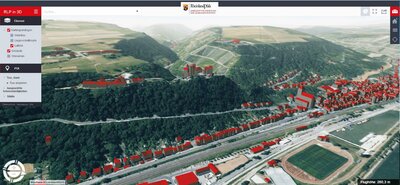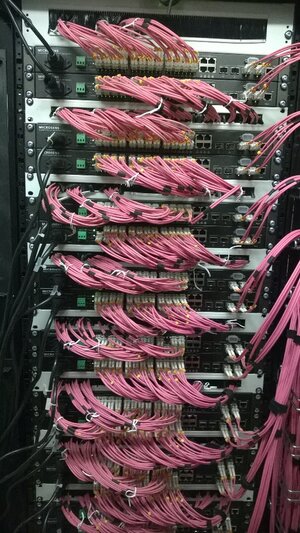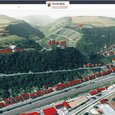
State Office for Surveying and Geographical Basic Information Refurbishes its IT Environment at Record Speed

Surveying Rhineland-Palatinate in Detail
Each position within the federal state has to be determined according to its location, height, and gravity. It is one of the principal tasks of the State Office to create this area reference in terms of surveying technology. In addition, the employees of the agency are continuously collecting and updating geo-topographical information and are issuing numerous topographical maps in different scales. In former times, the surveyors regularly had to perform field work on-site to do this. Today, satellites are capturing the earth surface, and this information is further honed with aerial photographs taken from aircrafts. To classify this information: Even objects with a size of 20 centimetres can be identified on the aerial photograph by means of billion-fold scanning with image sensors. In metropolitan areas, the resolution even reaches up to 10 centimetres. The data volume to be dealt with in this context is huge: If a single aerial photograph in colour is taken including an infra-red channel with a size of 2 x 2 kilometres at a resolution of 20 centimetres, a data volume of 400 MB is created. If the resolution is increased to 10 centimetres, the data volume is quadrupled. Under consideration of the storage requirements for the productive environment, as well as further data, this sums up to a total data volume of approximately 120 Terabytes, which is stored and administrated by the State Office. And it is growing continuously.
Fast Solution Required
At the end of 2014, the agency received the surprising news that it had to vacate the previous building within a few months time. Fortunately, appropriate premises could be found for the 320 employees in the short term. It was found out quickly, however, that the network infrastructure contained on these premises could not be used. Together with the State Office for Data and Information (LDI), which accompanied the project as the central IT service provider of the federal state, the agency opted for a completely new fiber optic cabling for the building. This decision eliminated the length restriction of copper to a maximal trunk distance of 100 metres. The parapet channels did not have to be enlarged and additional floor distribution units became superfluous. At the same time, the State Office outsourced numerous IT services to the LDI, in particular in terms of data storage. The question was raised how the individual workplaces were to be connected to the network. Jean Sachreiter was looking for a solution enabling him to use the fiber optic accesses in the office and only to connect the end devices via copper. He quickly came up with the FTTO solution of MICROSENS: Here, micro-switches are directly installed in the cable channel and offer transmission capacities of up to 1 Gbps. They can be connected to the central switch in a star-shaped topology without requiring additional floor distribution units.
In technical terms, this concept precisely met the requirements of the IT director. Moreover, MICROSENS, being a German manufacturer, was able to supply both the required micro-switches and the necessary layer 2 switches at short notice and even at favourable conditions. This abundance of favourable aspects were convincing, and, thus, the agency very quickly decided to equip the new building with FTTO technology.

High Performance Infrastructure Set up at Record Speed
Together with his team, Jean Sachreiter systematically planned the setup of the new network and defined the steps required to migrate the technology. In a first phase, the IT team transferred all servers of the State Office for Surveying, which hitherto had been local servers, to the central data center of the LDI in Mainz at the end of June 2015. For this purpose, a 1-Gbps-WAN connection to the old building was temporarily leased to be able to access the data as usual. Later on, this trunk was replaced with a 10-Gbps-connection to the new building.
At the end of July, the migration of the complete IT infrastructure was accomplished: On a Friday, all PCs were disassembled, and as soon as on Monday next, all employees were working smoothly in the new network. The advantage of this approach obviously entailed that the complete cabling and the assembly of the micro-switches could previously be performed in the parapet channel of the offices. All offices are supplied by layer 2 switches in the distribution room with fiber optic cables in a star-shaped topology. All News Detailemployees are offered a micro-switch with a bandwidth of 1 Gbps. The workstations, PCs, and telephones are connected with standard copper cables to this switch. This also makes additional mains plugs for the IP phones superfluous: They are directly supplied with power via the Power-over-Ethernet function of the micro-switches. Moreover, the integrated management software of MICROSENS has major benefits to offer. It ensures port security and supports all management standards. All in all, Jean Sachreiter is quite enthusiastic about the new infrastructure: "Via the MICROSENS switches, our users are able to access all data records quickly and reliably, without the necessity of buying expensive fiber optic network interface cards for each computer. The usage of the IP telephony including Quality of Service is also working smoothly." The IT director is sure that in a few years the micro-switches will process rates of up to 10 Gbps. After all, the hunger for data is far from being satisfied in the State Office for Surveying and Geographical Basic Information.
About MICROSENS
Transmitting information via fiber optic connections offers numerous benefits. MICROSENS GmbH & Co. KG recognised this very early on. As one of the pioneers, the company has developed and produced high-performance communications and transmission systems in Germany since 1993. Individually matched to the demands of diverse usage areas and embedded in comprehensive concepts for individual sectors. But, above all, close to the customer. Technical challenges from customer projects are incorporated directly into product development. This way, IP-based automation solutions are created for modern buildings, cost-efficient network concepts for the office and workspace, robust and fail-safe solutions for industrial environments, optical transport systems future-oriented wide area networks and efficient coupling of sites and computer centres.













